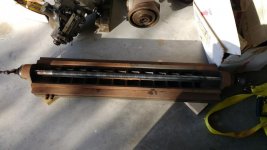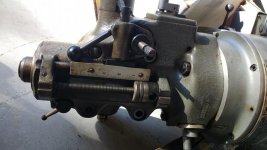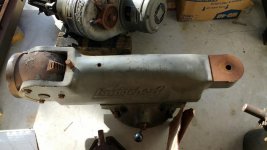Hello all,
My name is Nick. I am a degreed mechanical engineer working in manufacturing QC. I am mechanically inclined, but have little hands on experience with machining. I did some machine work in college and loved it, but haven't gotten my hands dirty since. My grandfather and uncle were master machinists and ran their own shop for many years. After my grandfather sold the business, he put some machines in storage (not climate controlled), where they stayed for many years. I think my uncle always wanted to get them running again, but as he aged he realized it wasn't going to happen, so he bestowed his Bridgeport mill to me.
I finally got it moved into its resting place in my garage last weekend. It is currently in 4 pieces: Column+knee, ram, head, and table. It has some surface rust, and the paint is flaking off in many placed, but it appears as if the moving parts are still free to move (the knee and table, at least).
I am interested in restoring it, but not necessary to factory perfection. I would like it to work (of course), and be reasonably accurate for home and hobby use.
I can get the specs of the machine when I get home, as he was able to provide a bunch of documentation in addition to the plates on the machine. I will get some photos as well.
All in all, my question is: where do I start? Its a daunting looking task which I have no experience with. I was thinking that removal of rust would be first to see what I am dealing with. Any guidance out there for a complete newbie? Any and all advice is greatly appreciated. Thank you!
Nick
My name is Nick. I am a degreed mechanical engineer working in manufacturing QC. I am mechanically inclined, but have little hands on experience with machining. I did some machine work in college and loved it, but haven't gotten my hands dirty since. My grandfather and uncle were master machinists and ran their own shop for many years. After my grandfather sold the business, he put some machines in storage (not climate controlled), where they stayed for many years. I think my uncle always wanted to get them running again, but as he aged he realized it wasn't going to happen, so he bestowed his Bridgeport mill to me.
I finally got it moved into its resting place in my garage last weekend. It is currently in 4 pieces: Column+knee, ram, head, and table. It has some surface rust, and the paint is flaking off in many placed, but it appears as if the moving parts are still free to move (the knee and table, at least).
I am interested in restoring it, but not necessary to factory perfection. I would like it to work (of course), and be reasonably accurate for home and hobby use.
I can get the specs of the machine when I get home, as he was able to provide a bunch of documentation in addition to the plates on the machine. I will get some photos as well.
All in all, my question is: where do I start? Its a daunting looking task which I have no experience with. I was thinking that removal of rust would be first to see what I am dealing with. Any guidance out there for a complete newbie? Any and all advice is greatly appreciated. Thank you!
Nick












